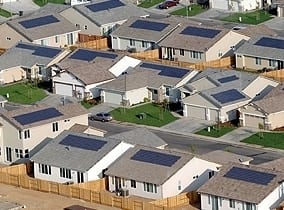AGL Energy has announced plans to develop what it describes as “the world’s largest battery storage ‘virtual power plant’” in South Australia, in a foretaste of what many expect to be the energy system of the future. The project will comprise a centrally controlled network of 1,000 residential and business battery storage systems with a combined total of 7MWh capacity that will both store rooftop solar power and help manage grid stability in the state.
It comes at a critical time for South Australia, which is leading the world in the uptake of solar and wind, and looking to add even more, at the same time as shutting down its “baseload” coal powered generation.
The $20 million virtual power plant, announced by AGL in Adelaide on Friday, will be developed over three phases in conjunction with the Australian Renewable Energy Agency, which has “conditionally committed” up to $5 million in funding to the project.

The hardware – the 1,000 battery systems – and the energy management software for the project will be supplied by US-based energy management company, Sunverge, which got the job through competitive tender.
According to AGL, the virtual power plant – which will have an output equivalent to a 5MW solar peaking plant – will work by using a cloud-connected intelligent control system that will allow the batteries to be directed in unison: a strategy aimed at helping both consumers to maximise solar self-consumption, and the broader community to manage state-wide peaks in electricity demand.
“If the batteries are operated independently (outside of the connected system) they cannot be relied on to provide grid services,” an AGL media statement said.
“When working together at this scale, they can be used to provide grid stability services by discharging at a time that will be of greatest benefit for the customer and the community.”
The move is an obvious one – and in an obvious location: South Australia leads the country with its high penetration of wind and solar energy, but also has some of its highest, and peakiest electricity prices, due largely to an over-reliance on gas-fired generation and an un-competitive energy market.
For AGL, it is a leap into the distributed energy future, with the opportunity to test, and even control, how distributed energy can be used to benefit both customers and utilities – and the greater grid.
And it offers swift validation of the utility’s February purchase of a minority stake in Sunverge, which AGL billed as an “early mover advantage” in the development of demand response management for “premises-based energy storage.”
“We are keen on the concept of a virtual power plant,” AGL chief Andy Vesey told an analysts briefing at the time.

For ARENA’s $5 million, it is a chance to prove that high penetration of renewables can be integrated in a way that not only cleans up the grid but helps to run it more smoothly.
Indeed, in a statement on Friday, ARENA CEO Ivor Frischknecht said that the $20 million project could point to solutions to South Australia’s grid challenges and reduce the risk of power price shocks in the state.
“This approach can ease local network constraints in South Australia, displace gas power and complement the Victorian interconnector, especially during times of peak demand,” he said.
“South Australia is the obvious place to start,” Frischknecht said later, in an interview with RenewEconomy. “But we expect it to be a big part of the future (throughout the country).”
“(Distributed battery storage) has four fairly obvious value streams,” he added, including for the consumer, for the market, for the network and as a back-up power system.
“These are the really obvious benefits to the scheme – and some of them are not available to grid-scale battery storage,” he said.
AGL’s Vesey, who attended the announcement with Frischknecht and SA treasurer and energy minister Tom Koutsantonis, said the “first of its kind” project was a win for all, but was keen to highlight the benefits to consumers.
“It offers consumers the opportunity to be part of the world’s largest virtual power plant, giving them greater ability to consume more of the energy generated from their own rooftop solar systems, lowering power bills, reducing emissions and purchasing a battery at a significant discount,” he said.
“We believe it will demonstrate alternative ways to manage peaks in energy demand, contributing to grid stability and supporting the higher penetration of intermittent, renewable generation on the grid,” he said.
“This project is core to AGL’s strategy of being a manager of distributed energy resources. It also leverages our investment in Sunverge and helps us to continue to improve the digital customer experience,” he said.
Koutsantonis – who has been a focus of much of the criticism over the state’s energy “crisis” – congratulated AGL for looking at innovative ways to use batteries to increase the penetration of renewables.
“The result is like adding a 5MW power station that can quickly deliver enough energy to power 1,000 South Australian homes where and when it’s needed most.
“We encourage others in the private sector to also consider how dispatchable renewable energy technology can be used to deliver electricity around-the-clock,” he said.
Frischknect said the cost of the project was an “all-in cost” – covering hardware, software and installation – and was expected to come down over the course of the scheme’s three-phase roll-out, as battery and balance of system costs fall.
“Australia is on the cusp of a battery storage revolution as technology costs continue to fall. ARENA is at the forefront of figuring out how batteries can best support renewable energy to provide affordable, reliable and sustainable power,” he said.
“It could also act as a catalyst and provide evidence for regulatory change to enable more Australian virtual power plants. ARENA funding support depends on the negotiation of a funding agreement, which will include comprehensive knowledge sharing outcomes.
“The knowledge would show a path to commercialisation and present lessons that regulators and other energy companies can learn from,” he said.








